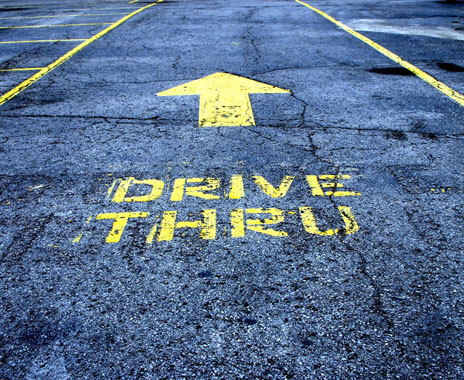The 2016 QSR Drive-Thru Study revealed that a whopping 60–70 percent of the revenue in the quick-service business comes from drive-thru sales. According to The NPD Group, drive-thru sales account for 57 percent of business at burger restaurants, 40 percent at Mexican-themed, and 38 percent at restaurants that serve chicken. In 2016, McDonald’s said approximately 70 percent of its U.S. sales come from drive-thru windows.
Americans make 12.4 billion trips to the drive-thru every year, so meals on-the-go are here to stay.
The drive-thru flow process, in general, goes like this: a consumer arrives at the drive thru, orders their food, receives their order, pays, and drives away. By breaking down these activities into components, technology can be applied to increase speed and efficiency.
Technology can impact these areas in the drive-thru process:
- Moving customers through the line
- Food and product preparation speed
- Accuracy in taking orders
- Order entry to the restaurant’s kitchen
- Payment
The key to increasing drive-thru sales is identifying the key choke-points that slow down the order process and finding solutions that alleviate these issues.
Choke-point No. 1: Traffic flow
This means fixing traffic in the entire restaurant environment, not just the parking lot. Imagine a world where once a customer opts-in, their vehicle can be pinpointed at any time, like the geo-tracking on a smartphone. Dual authentication can confirm customer identity and speed up traffic through the line. For example, let’s say Matt is driving Mary’s car. Matt’s phone will offer the secondary authentication, which is more specific and can provide geo or micro location. As soon as Matt pulls into the drive thru, the restaurant can determine Matt is the customer with a high degree of accuracy.
From that identification, a customer profile can be activated. Retailers can build the profile by reviewing prior orders from the customer and starting an algorithm for their menu production requirements. That data is compiled to generate menu analytics; with that analysis output is sent to the kitchen to automatically drop protein—a hamburger patty or chicken cutlet—onto the grill. If you speed up the line, you speed up the kitchen, in turn speeding up throughput, which increases sales.
New restaurants are being designed to accommodate new technologies. Designing a drive-thru for peak performance is new—the current architecture of legacy restaurants is not always conducive to enable optimal performance. Kitchens will also have to be re-designed to make way for innovation.
Choke-point No. 2: Order entry and subsequent notification to the kitchen
Providing various formats to place orders can certainly speed things up, like ordering over auto infotainment systems or making arrangements with large quick serves to order on a smartphone. In addition, knowing the customer who is ordering can enable more personalization. A cashier who knows the customer will enhance their experience, while also speeding up the process. Dual authentication is helpful as well, allowing customers the option to replicate a previous order. This saves the cashier the time of manually placing a new order for the same items.
Choke-point No. 3: The payment process
Automated payments can allow food to come out faster. Customer payments that are linked to an account are crucial here, as they allow for simply clicking a button for an automatic payment.
Technology can help order accuracy in many ways, such as with a self-checkout solution. Utilizing a weight-scale system, food can be rung up by measuring its weight against load cells. Retailers attach weight to each item, then compare weight with menu items which can be adjusted with tolerances. This solution could help streamline order accuracy, such as sending an alert when a whole item is missing, and boost customer satisfaction.
The future of the drive thru is driven by the application and adoption of technologies that increase the number of customers and minimize choke-points. Recognizing choke-points is the first step to developing targeted solutions for streamlining drive-thru processes and efficiencies.
Technology providers are addressing and alleviating many choke-points through IoT connected solutions, including automotive-related infotainment technologies systems, digital content distribution and management, automated processes for food service retail, and essential back office quick service software. At some point in the not-too-distant future, the drive thru might not require any driving at all.







